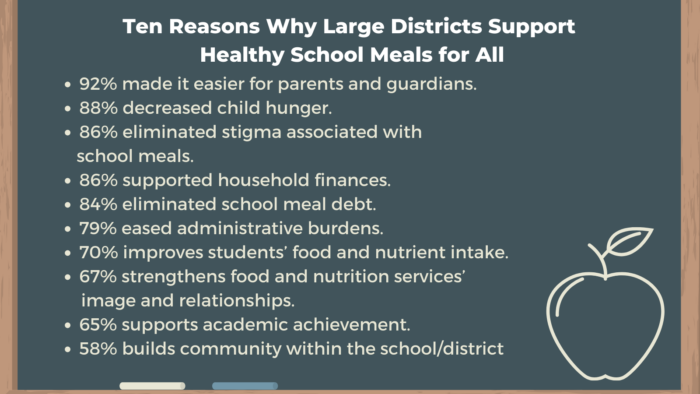June 28, 2023
The Food Research & Action Center (FRAC) recently released the Large School District Report: Operating School Nutrition Programs as the Nation Recovers From the Pandemic. FRAC’s report details school meals participation and operations in 91 school districts across 40 states and the District of Columbia in April 2022 and October 2022. Combined, the districts include 10,748 schools and have an enrollment of 6.52 million students.
The 2022–2023 school year marked the end of the nationwide waivers that granted schools certain flexibilities in operating the child nutrition programs. Of particular importance was the end of the Seamless Summer Option waiver, which allowed schools to offer all students school meals at no charge. Most schools (including the majority of school districts surveyed) had to return to the tiered free, reduced-priced, and paid eligibility system, causing millions of children to lose access to free school meals and creating administrative and operational burdens for school districts.
Key findings include:
- In April 2022, all 91 school districts (100 percent) offered school meals to all students at no charge districtwide, whereas in October 2022 only 33 school districts (36 percent) offered free school meals to all students districtwide.
- Average daily participation in school breakfast decreased by 100,747 students across all surveyed districts (5 percent) — from 1.84 million children participating in breakfast on an average day in April 2022 to 1.74 million children participating in October 2022.
- Average daily participation in school lunch decreased by 250,738 students (7 percent) — from 3.61 million students participating in lunch on an average day in April 2022 to 3.36 million students participating in October 2022.
- The combined reach of breakfast trailed lunch in both April 2022 and October 2022. In October 2022, only 56 students from households with low incomes participated in school breakfast for every 100 students from households with low incomes that participated in school lunch.
- Districts continue to report many challenges, such as rising food prices, labor shortages, and supply chain disruptions. Additionally, 91 percent of the 58 districts that charged for meals in at least one school during the 2022–2023 school year reported increased school meal debt.
- Nearly every surveyed district reported numerous benefits to offering school meals to all students at no charge, including decreased child hunger, reduced stigma, elimination of school meal debt, and supporting parents and guardians.

As schools and advocates plan for the 2023–2024 school year, it is important for Congress to pass legislation to ensure that all students have access to healthy school meals and that school districts have the support needed to operate viable programs:
- The Universal School Meals Program Act of 2023 (S. 1568, H.R. 3240) would make Healthy School Meals for All available nationwide, increase reimbursement rates, and expand access to meals after school, during the summer, and at child care.
- The School Meals Expansion Act of 2023 (H.R. 2567) would allow more schools to offer school meals to all their students through the Community Eligibility Provision by increasing funding (raising the multiplier that determines the school’s reimbursement from 1.6 to 2.5) and lowering the eligibility needed to participate.
- The Healthy Meals Help Kids Learn Act of 2023 (H.R. 1269) would permanently increase the federal reimbursement rates for school breakfast by $0.28 and school lunch by $0.45, thus supporting the financial viability of school nutrition programs, and helping to ensure children receive the most nutritious and appealing meals possible.
- In addition, the gap in participation in school breakfast compared to lunch highlights the need to support breakfast after the bell programs that overcome many of the barriers to school breakfast participation to help ensure that children can start the school day ready to learn.
This report underscores the importance of Healthy School Meals for All, demonstrating that when school meals are offered free of charge and integrated into a school’s culture, participation increases, stigma decreases, and schools’ administrative burden eases, thus giving all children access to the nutrition necessary for their success.


